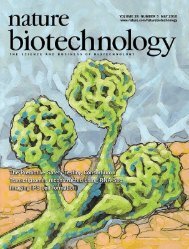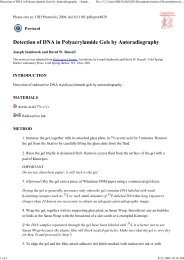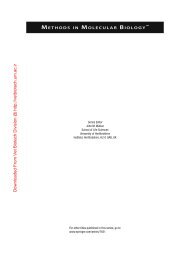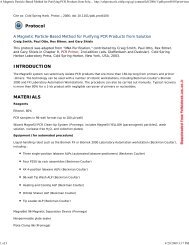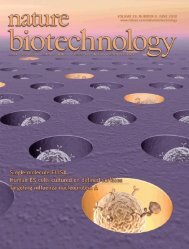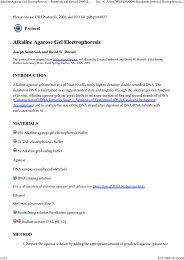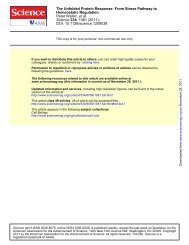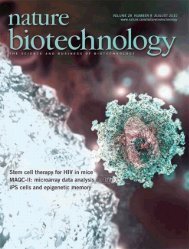l e t t e r sRational design of cationic lipids for siRNA deliverySean C Semple 1,6 , Akin Akinc 2,6 , Jianxin Chen 1,5 , Ammen P Sandhu 1 , Barbara L Mui 1,5 , Connie K Cho 1 ,Dinah W Y Sah 2 , Derrick Stebbing 1 , Erin J Crosley 1 , Ed Yaworski 1 , Ismail M Hafez 3 , J Robert Dorkin 2 , June Qin 2 ,Kieu Lam 1 , Kallanthottathil G Rajeev 2 , Kim F Wong 3 , Lloyd B Jeffs 1 , Lubomir Nechev 2 , Merete L Eisenhardt 1 ,Muthusamy Jayaraman 2 , Mikameh Kazem 3 , Martin A Maier 2 , Masuna Srinivasulu 4 , Michael J Weinstein 2 ,Qingmin Chen 2 , Rene Alvarez 2 , Scott A Barros 2 , Soma De 2 , Sandra K Klimuk 1 , Todd Borland 2 ,Verbena Kosovrasti 2 , William L Cantley 2 , Ying K Tam 1,5 , Muthiah Manoharan 2 , Marco A Ciufolini 4 ,Mark A Tracy 2 , Antonin de Fougerolles 2 , Ian MacLachlan 1 , Pieter R Cullis 3 , Thomas D Madden 1,5 & Michael J Hope 1,5© 2010 Nature America, Inc. All rights reserved.We adopted a rational approach to design cationic lipids foruse in formulations to deliver small interfering RNA (siRNA).Starting with the ionizable cationic lipid 1,2-dilinoleyloxy-3-dimethylaminopropane (DLinDMA), a key lipid component ofstable nucleic acid lipid particles (SNALP) as a benchmark,we used the proposed in vivo mechanism of action of ionizablecationic lipids to guide the design of DLinDMA-based lipidswith superior delivery capacity. The best-performing lipidrecovered after screening (DLin-KC2-DMA) was formulatedand characterized in SNALP and demonstrated to havein vivo activity at siRNA doses as low as 0.01 mg/kg in rodentsand 0.1 mg/kg in nonhuman primates. To our knowledge, thisrepresents a substantial improvement over previous reports ofin vivo endogenous hepatic gene silencing.A key challenge in realizing the full potential of RNA interference(RNAi) therapeutics is the efficient delivery of siRNA, the moleculesthat mediate RNAi. The physicochemical characteristics of siRNA—high molecular weight, anionic charge and hydrophilicity—preventpassive diffusion across the plasma membrane of most cell types.Therefore, delivery mechanisms are required that allow siRNA toenter cells, avoid endolysosomal compartmentalization and localizein the cytoplasm where it can be loaded into the RNA-inducedsilencing complex. To date, formulation in lipid nanoparticles (LNPs)represents one of the most widely used strategies for in vivo deliveryof siRNA 1,2 . LNPs represent a class of particles comprised of differentlipid compositions and ratios as well as different sizes and structuresformed by different methods. A family of LNPs, SNALP 3–6 , is characterizedby very high siRNA-encapsulation efficiency and small,uniformly sized particles, enabled by a controlled step-wise dilutionmethodology. LNPs, including SNALP, have been successfully used tosilence therapeutically relevant genes in nonhuman primates 6–8 andare currently being evaluated in several clinical trials.An empirical, combinatorial chemistry–based approach recentlyidentified novel materials for use in LNP systems 7 . A key feature ofthis approach was the development of a one-step synthetic strategythat allowed the rapid generation of a diverse library of ~1,200 compounds.This library was then screened for novel materials capableof mediating efficient delivery of siRNA in vitro and in vivo. Here, weinstead used a medicinal chemistry (that is, structure-activity relationship)approach, guided by the putative in vivo mechanism of actionof ionizable cationic lipids, for rational lipid design. Specifically,we hypothesized that after endocytosis, the cationic lipid interactswith naturally occurring anionic phospholipids in the endosomalmembrane, forming ion pairs that adopt nonbilayer structures anddisrupt membranes (Fig. 1) 9–12 . We previously advanced the conceptFigure 1 Proposed mechanism of action for membrane disruptive effects ofcationic lipids and structural diagram of DLinDMA divided into headgroup,linker and hydrocarbon chain domains. In isolation, cationic lipids andendosomal membrane anionic lipids such as phosphatidylserine adopt acylindrical molecular shape, which is compatible with packing in a bilayerconfiguration. However, when cationic and anionic lipids are mixed together,they combine to form ion pairs where the cross-sectional area of the combinedheadgroup is less than that of the sum of individual headgroup areas inisolation. The ion pair therefore adopts a molecular ‘cone’ shape, whichpromotes the formation of inverted, nonbilayer phases such as the hexagonalH II phase illustrated. Inverted phases do not support bilayer structure and areassociated with membrane fusion and membrane disruption 9,21 .+ – + –Cylindrical shape supportsbilayer structureBilayerCone shape disruptsbilayer structureHexagonal H IIDLinDMAHeadgroupLinkerHydrocarbonchains1 Tekmira Pharmaceuticals, Burnaby, British Columbia, Canada. 2 Alnylam Pharmaceuticals, Cambridge, Massachusetts, USA. 3 Department of Biochemistry andMolecular Biology and 4 Department of Chemistry, University of British Columbia, Vancouver, British Columbia, Canada. 5 Present address: Alcana Technologies,Vancouver, British Columbia, Canada. 6 These authors contributed equally to this work. Correspondence should be addressed to S.C.S. (ssemple@tekmirapharm.com)or A.A. (aakinc@alnylam.com).Received 16 September 2009; accepted 17 December 2009; published online 17 January 2010; doi:10.1038/nbt.1602172 VOLUME 28 NUMBER 2 FEBRUARY 2010 nature biotechnology
l e t t e r saRelative serum factor VIIprotein (%)1201008060402000.01 0.1 1 10 100Factor VII siRNA dose (mg/kg)cMe 2 NOOMe 2 NRROORDLinDMAMe 2 NROORRMe 2 NMe 2 NODLinDAPO RRO Me2 NDLin-K-DMA DLin-KC2-DMA DLin-KC3-DMA DLin-KC4-DMAR =bRelative serum factor VIIprotein (%)1201008060402000.01 0.1 1 10Factor VII siRNA dose (mg/kg)OOROROORRFigure 2 In vivo evaluation of novel cationic lipids. (a) Silencingactivity of DLinDAP (), DLinDMA (), DLin-K-DMA () and DLin-KC2-DMA (•) screening formulations in the mouse Factor VII model.All LNP-siRNA systems were prepared using the preformed vesicle(PFV) method and were composed of ionizable cationic lipid, DSPC,cholesterol and PEG-lipid (40:10:40:10 mol/mol) with a FactorVII siRNA/total lipid ratio of ~0.05 (wt/wt). Data points are expressedas a percentage of PBS control animals and represent group mean(n = 5) ± s.d., and all formulations were compared within the samestudy. (b) Influence of headgroup extensions on the activity ofDLin-K-DMA. DLin-K-DMA () had additional methylene groups addedbetween the DMA headgroup and the ketal ring linker to generateDLin-KC2-DMA (•), DLin-KC3-DMA () and DLin-KC4-DMA (). Theactivity of PFV formulations of each lipid was assessed in the mouseFactor VII model. Data points are expressed as a percentage of PBScontrol animals and represent group mean (n = 4) ± s.d. (c) Chemicalstructures of novel cationic lipids.© 2010 Nature America, Inc. All rights reserved.of using ionizable cationic lipids with pK a s < pH 7.0 to efficientlyformulate nucleic acids at low pH and maintaining a neutral or lowcationic surface charge density at pH 7.4 (ref. 13). This strategy shouldprovide better control of the circulation properties of these systemsand reduce nonspecific disruption of plasma membranes. As positivecharge density is minimal in the blood but increases substantiallyin the acidic environment of the endosome, this should activatethe membrane-destabilizing property of the LNP. Although theseattributes may account for the activity of these systems upon internalizationby hepatocytes, they do not necessarily explain the highlevels of hepatic biodistribution observed for many LNPs, includingSNALP. Although these LNPs do not specifically include a targetingligand to direct them to hepatocytes after systemic administration,it is possible that these LNPs associate with one or more proteins inplasma that may promote hepatocyte endocytosis.The ionizable cationic lipid DLinDMA has proven to be highlyeffective in SNALP, has been extensively tested in rodents and nonhumanprimates, and is now being evaluated in human clinicaltrials. Therefore, we selected it as the starting point for the designand synthesis of novel lipids. We chose the mouse Factor VII model 7 ,as the primary in vivo screening system to assess functional LNPmediateddelivery to hepatocytes. Briefly, C57BL/6 mice receiveda single dose of LNP-formulated Factor VII siRNA through bolustail vein injection and serum was collected from animals 24 h afteradministration to analyze Factor VII protein level. The initial screeningof LNP-siRNA systems was conducted using LNPs prepared bya preformed vesicle method 14 and composed of ionizable cationiclipid, distearoylphosphatidylcholine (DSPC), cholesterol and PEGlipid(40:10:40:10 mol/mol), with a Factor VII siRNA/total lipid ratioof ~0.05 (wt/wt). Although not a bilayer-destabilizing lipid, a smallamount of phosphatidylcholine was incorporated into the LNP tohelp stabilize the LNP both during formulation and while it was incirculation. A short acyl chain PEG-lipid was incorporated into theLNP to control particle size during formulation, but is designed toleave the LNP rapidly upon intravenous injection. As our goal wasto identify novel ionizable cationic lipids for use in LNPs, we aimedto minimize other effects by using a single robust composition andset of formulation conditions suitable for all novel lipids tested. Thepreformed vesicle method employing the composition listed aboveprovides a convenient platform for such testing, but uses a differentformulation process, a different lipid composition and a differentsiRNA/lipid ratio than SNALP. The structure of DLinDMA can bedivided into three main regions: the hydrocarbon chains, the linkerand the headgroup (Fig. 1). A detailed structure-function study toinvestigate the impact of increasing the number of cis double bondsin the hydrocarbon chains found the linoleyl lipid containing twodouble bonds per hydrocarbon chain (DLinDMA) to be optimal 15 .We therefore maintained the linoleyl hydrocarbon chains present inDLinDMA as an element in our lipid design, and focused on optimizingthe linker and headgroup moieties.The linker region in a bilayer structure resides at the membraneinterface, an area of transition between the hydrophobic membranecore and hydrophilic headgroup surface. Our approach to linkermodification of DLinDMA involved introducing groups expected toexhibit different rates of chemical or enzymatic stability and to spana range of hydrophilicity. A variety of these rationally designed lipidswere made, characterized and tested (Supplementary Syntheses 1 andSupplementary Table 1). LNPs based on the ester-containing lipidDLinDAP showed substantially reduced in vivo activity comparedto LNPs based on the alkoxy-containing lipid DLinDMA (Fig. 2).Further, LNPs based on DLin-2-DMAP, a lipid with one alkoxy linkageand one ester linkage, yielded activity intermediate betweenDLinDAP- and DLinDMA-based LNPs (Supplementary Table 1).Although it is uncertain why the ester-containing lipids are considerablyless active in vivo, we speculate that the diester lipid (DLinDAP)is relatively inactive because it is more readily hydrolyzed in vivothan the alkoxy analog (DLinDMA), and therefore, unable to eitherprotect the siRNA adequately before release from the endosomeand/or survive long enough in the endosome to disrupt the membrane.These hypotheses are being investigated. LNPs based on lipidscontaining carbamate or thioether linkages also resulted in dramaticallyreduced in vivo activity. Interestingly, the introduction of a ketalring linker into DLinDMA resulted in LNPs that were ~2.5-fold morepotent in reducing serum Factor VII protein levels relative to theDLinDMA benchmark, with an ED 50 (that is, dose to achieve 50%gene silencing) of ~0.4 mg/kg versus 1 mg/kg, respectively (Fig. 2).Given the importance of positive charge in the mechanismof-actionhypothesis guiding the lipid design, the effects of structuralchanges in the amine-based headgroup were investigated in the contextof DLin-K-DMA as the new benchmark lipid. A series of headgroupmodifications were made, characterized and tested to explorethe effects of size, acid-dissociation constant and number of ionizablegroups (Supplementary Syntheses 2 and Supplementary Table 2).Piperazino, morpholino, trimethylamino or bis-dimethylamino modificationstested were not better than the benchmark dimethylaminoheadgroup of DLin-K-DMA. As an additional parameter, the distancebetween the dimethylamino group and the dioxolane linker was variedby introducing additional methylene groups. This parameter cannature biotechnology VOLUME 28 NUMBER 2 FEBRUARY 2010 173
- Page 3 and 4:
volume 28 number 2 february 2010COM
- Page 5 and 6:
in this issue© 2010 Nature America
- Page 7 and 8:
© 2010 Nature America, Inc. All ri
- Page 10 and 11:
NEWS© 2010 Nature America, Inc. Al
- Page 12 and 13:
NEWS© 2010 Nature America, Inc. Al
- Page 14 and 15:
NEWS© 2010 Nature America, Inc. Al
- Page 16 and 17:
© 2010 Nature America, Inc. All ri
- Page 18 and 19:
© 2010 Nature America, Inc. All ri
- Page 20 and 21:
© 2010 Nature America, Inc. All ri
- Page 22 and 23:
NEWS feature© 2010 Nature America,
- Page 24 and 25:
uilding a businessComing to termsDa
- Page 26 and 27:
uilding a business© 2010 Nature Am
- Page 28 and 29:
correspondence© 2010 Nature Americ
- Page 30 and 31: correspondence© 2010 Nature Americ
- Page 32 and 33: correspondence© 2010 Nature Americ
- Page 34 and 35: correspondence© 2010 Nature Americ
- Page 36 and 37: case studyNever againcommentaryChri
- Page 38 and 39: COMMENTARY© 2010 Nature America, I
- Page 40 and 41: COMMENTARY© 2010 Nature America, I
- Page 42 and 43: patents© 2010 Nature America, Inc.
- Page 44 and 45: patents© 2010 Nature America, Inc.
- Page 46 and 47: news and viewsChIPs and regulatory
- Page 48 and 49: news and viewsFrom genomics to crop
- Page 50 and 51: news and views© 2010 Nature Americ
- Page 52 and 53: news and views© 2010 Nature Americ
- Page 54 and 55: e s o u r c eRational association o
- Page 56 and 57: e s o u r c e© 2010 Nature America
- Page 58 and 59: e s o u r c e© 2010 Nature America
- Page 60 and 61: e s o u r c e© 2010 Nature America
- Page 62 and 63: © 2010 Nature America, Inc. All ri
- Page 64 and 65: B r i e f c o m m u n i c at i o n
- Page 66 and 67: i e f c o m m u n i c at i o n sAUT
- Page 68 and 69: lettersa1.5 kb hVPrIntron 112.5 kbA
- Page 70 and 71: letters© 2010 Nature America, Inc.
- Page 72 and 73: letters© 2010 Nature America, Inc.
- Page 74 and 75: l e t t e r sReal-time imaging of h
- Page 76 and 77: l e t t e r sFigure 2 Time-lapse li
- Page 78 and 79: l e t t e r s© 2010 Nature America
- Page 82 and 83: l e t t e r s© 2010 Nature America
- Page 84 and 85: l e t t e r s© 2010 Nature America
- Page 86 and 87: sample fluorescence was measured as
- Page 88 and 89: careers and recruitmentFourth quart




